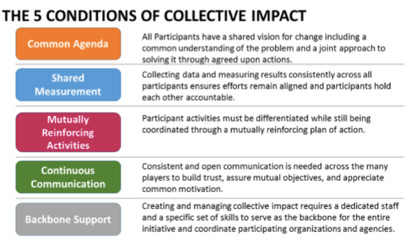Cities Reducing Poverty (CRP) members across Canada apply Collective Impact approaches as they work to move the needle on poverty in their communities. They frame their work under five core conditions, first identified in 2011 by John Kania and Mark Kramer of FSG Consulting, that have been identified as being shared by successful Collective Impact initiatives.
These five core conditions are:
- A common agenda;
- Shared measurement;
- Mutually reinforcing activities;
- Continuous communication; and,
- Backbone support.
Dufferin County is a great example of how these conditions can be applied to poverty work.

The Dufferin County Equity Collaborative (DCEC), brought together the Dufferin County Poverty Reduction Task Force and the Central West Local Health Integration Network poverty sub-group under one Terms of Reference. Serving as the backbone for the entire initiative, DCEC has a defined organizational structure with a required set of skills, and capacity to devote both time and expertise. Co-Chairs organizations – Public Health and Dufferin County Community Services (DCCS) – provide resources on an as-needed basis to initiatives, and part-time dedicated support is available from the DCCS Policy Analyst and DC MOVES coordinator.
DCEC’s participating organizations agree both on a common definition and work towards a common goal of Equity. They are working to identify multi-level indicators to be able to consistently collect and measure results. They conducted data sharing meetings towards shared measurement to find out who had what data and to determine what could be shared, and implemented an outcomes diary to collect data from workgroup participants. This approach enables participants to appreciate their respective contributions, learn from each other, and continuously improve measures and outcomes.
DCEC’s diverse stakeholders mutually reinforce each other’s activities, with each one undertaking a specific set of activities at which they excel, and with these efforts supported by and coordinated with the activities of its partners. Knowing what each other is doing and understanding challenges and gaps has allowed the group to leverage knowledge and services, close gaps, and provide better service to residents.
DCEC engages in continuous communication by deliberately coming together for productive bi-monthly meetings for decision making across all voting members and the larger DCEC community. Partnering organizations have built trust across sectors to the point that they recognize and appreciate each one’s respective efforts, and understand that their interests will be treated fairly.
Kania and Kramer recognize that the successful application of Collective Impact as a model for social progress stems from the “heightened vigilance that comes from multiple organizations looking for resources and innovations through the same lens, the rapid learning that comes from continuous feedback loops, and the immediacy of action that comes from a unified and simultaneous response among all participants.”
The framing of Collective Impact through the lens of its five conditions has greatly supported Cities Reducing Poverty members across Canada to address the complex issue of poverty, and to create lasting solutions on a large scale.
Learn More:
- Read Collective Impact in Practice for other examples of how cities are applying these principles to their own initiatives.
- Learn more about the The Dufferin County Equity Collaborative
- Explore Tamarack's Collective Impact resources





